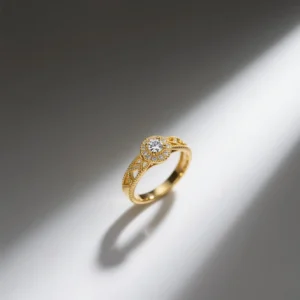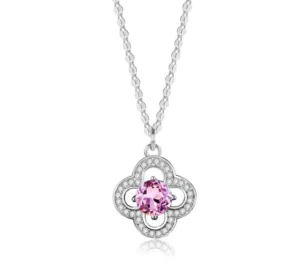Light’s dance with gemstones echoes Earth’s ancient rhythms. The refractive index (RI) is no mere lab number—it unlocks a gem’s identity, radiance, and geological story. Mastering RI transforms analysis into appreciation, revealing how nature sculpts light into prismatic wonders that dazzle and endure.

What is the Refractive Index of Gemstone?
The refractive index (RI) is a fundamental optical property that quantifies how light propagates through a gemstone. It is defined as the ratio of the speed of light in a vacuum to its speed within the gemstone. For example, diamond’s RI of 2.42 slows light significantly, creating its iconic sparkle. Conversely, quartz (RI ~1.54) allows for faster light transmission, resulting in a softer brilliance.
Why does the Refeactive Index Vary?
The refractive index (RI) is governed by crystal structure and chemistry. Cubic zirconia, for instance, replicates the brilliance of a diamond through its dense atomic packing, while organic gems such as amber achieve transparency through their resinous composition. Heat treatment can alter the RI by modifying the internal stress patterns.
What is Double Refraction?
Double refraction, also known as birefringence, is an optical phenomenon that occurs in certain crystalline gemstones. When a single ray of light enters the crystal, it splits into two separate rays that travel at different speeds and in different directions. Skilled cutters often orient gems to emphasise or mitigate such effects, shaping their visual impact.

How to Measure the Refractive Index of Gemstones?
Gemologists employ a refractometer, applying contact liquid (e.g., diiodomethane) to eliminate air gaps. Light passing through the gem projects a visible dark line, indicating the refractive index. For double-refractive gems, rotation yields dual readings for doubly refractive gems, with higher values denoting greater light dispersion.
Practical Applications in Gemology
Authenticity Verification: Synthetic spinel (RI 1.72) often mimics ruby but diverges in RI and fluorescence.
Cut Optimization: High-RI stones like Moissanite (RI 2.65–2.69) demand precise facet angles to maximize light return.
Enhancement Detection: Resin-filled fractures in emeralds create RI mismatches between treated and untreated areas
Methods of Artificially Altering Refractive Index
Vigilance in gemstone acquisition is essential to avoid deceptive enhancements.
Filling treatment: Glass filling causes refractive index abnormalities in emeralds
Coated gemstones: Titanium dioxide coating alters surface reflectance
Diffusion treatment: Blue diamond surface coloring does not affect internal refractive values

Refractive Index in Gemstone Identification
Refractometric analysis enables unambiguous differentiation between authentic gemstones and artificial imitations, with glass and other materials typically exhibiting refractive indices significantly below those of natural minerals. Collectors often prioritize RI alongside Mohs hardness and specific gravity for holistic gem evaluation
| Gemstone | Refractive Index Range | Diagnostic Significance |
| Ruby | 1.76–1.77 | Distinguished from garnet |
| Emerald | 1.57–1.60 | Identifies treatments |
| Sapphire | 1.76–1.77 | Confirms corundum origin |
| Opal | 1.37–1.52 | Detects synthetic variants |
Gemstones with High Refractive Index
Gems with high refractive indices (RI > 1.70) exhibit exceptional brilliance and fire due to their intense bending of light. Their optical properties directly influence their value and aesthetic appeal. Notable examples include:
Diamond(RI: 2.42): Renowned for its unmatched sparkle, diamond’s RI maximizes light dispersion, creating rainbow flashes.
Moissanite(RI: 2.65–2.69): Surpasses diamond in RI, offering vibrant fire but with subtle double refraction.
Ruby/Sapphire(RI: 1.76–1.77): Their high RI enhances color saturation, making them prized for luxury jewelry.
| Gemstone | RI Range | Birefringence | Key Identification Notes |
| Kim cương | 2.417–2.419 | None | Highest natural RI; adamantine luster |
| Hồng ngọc | 1.762–1.788 | 0.008 | Glass-filled variants show gas bubbles (e.g., Bi-based glass) |
| Đá quý | 1.760–1.778 | 0.008 | Consistent across colors; silk inclusions |
| Spinel | 1.712–1.762 | None | Often mistaken for ruby/sapphire, single refractive |
| Demantoid Garnet | 1.880–1.940 | None | “Horsetail” inclusions: high dispersion |
| Ngọc lục bảo | 1.577–1.583 | 0.006 | Colombian: lower RI (1.577); Zambian: higher (1.583) |
| Aquamarine | 1.564–1.596 | 0.006 | Low inclusions; pale blue to greenish-blue |
| Topaz | 1.609–1.643 | 0.010 | Perfect cleavage; high fracture risk |
| Tourmaline | 1.614–1.666 | 0.018 | Strong pleochroism; bi-color varieties common |
| Đá peridot | 1.650–1.703 | 0.038 | Pronounced doubling; oily luster |
| Tanzanite | 1.691–1.700 | 0.009 | Trichroic (blue/violet/yellow); heat-treated |
| Opal | 1.37–1.52 | None | Play-of-color > RI dependence; porous structure |
| Ngọc bích | 1.654–1.688 | 0.013 | “Imperial jade”: RI ~1.66; granular texture |
| Amber | 1.539–1.545 | None | Low RI; UV fluorescence; organic origin |
| Cubic Zirconia | 2.15–2.18 | None | Synthetic; higher dispersion than diamond |
| ngọc trai | 1.52–1.69 | None | Organic; nacre thickness affects luster |
The Takeaway
For gemstone jewelry, the refractive index (RI) is a cornerstone, defining a gemstone’s optical identity and aesthetic appeal. By quantifying how light bends within a material, the RI enables the precise identification of gems and distinguishes natural stones from synthetics. The RI’s role transcends aesthetics, becoming embedded in the legacy of gemstone value and innovation.





